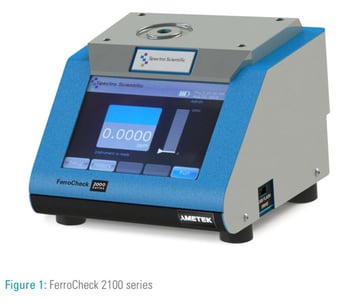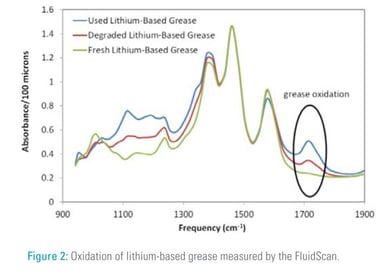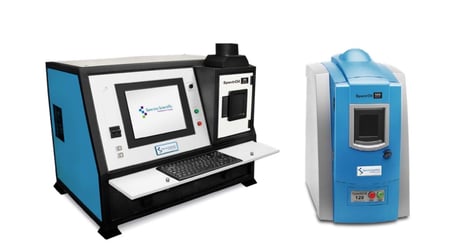Introduction
Extending lubricant condition monitoring programs to include grease analysis
Onsite oil analysis is an effective tool to quickly analyze samples and optimize maintenance activities. As part of a comprehensive condition based maintenance program (CBM), oil analysis proves to be an effective tool to compliment other diagnostic technologies like vibration analysis, infrared thermography and ultrasound technology. However, when the equipment is grease lubricated, this important Lubrication monitoring step is often overlooked.

SKF states that 80% of the world’s bearings are grease lubricated, leaving a vast opportunity to incorporate grease analysis techniques into the overall CBM strategy. The Electric Power Research Institute (EPRI), suggests nearly 50% of bearing failures are related to poor lubrication and contamination (1). The development of grease condition monitoring standards, ASTM D7718 and ASTM D7918, have laid the foundation for a consistent methodology to sample and test grease to implement condition monitoring strategies. By monitoring a few key data points, such as wear, oxidation and additive health, the asset manager has the ability to transition from calendar-based to condition-based change outs. This has the potential to save hundreds of thousands of dollars per year for an owner of a large fleet. The wind, rail and automotive robotics industries are currently implementing these strategies into their programs and potentially avoiding thousands in maintenance costs by predicting failures and extending greasing intervals. Historically, incorporating any kind of CBM strategy into grease lubricated components has been a challenge. The small quantity of grease typically available on an in-service component and the limited amount of testing available for small quantities of grease, often presents barriers for routine grease sampling and analysis as part of a comprehensive CBM Program. To address these challenges, grease sampling tools are available to capture a representative sample from a bearings and gears requiring as little as one gram of grease. Onsite analysis tools are available to assess wear and physical properties of the grease.
This simple sampling technique can be used in a variety of industries including but not limited to wind, rail, robotics, mining and nuclear to sample a large number of grease lubricated components and evaluate next actions based on criticality of the data. Periodic sampling and analysis of the grease from these components can provide asset owners a clearer picture of equipment health, determine grease condition for optimal change-out periods and pinpoint latent issues that can be addressed prior to failure. This application note will discuss grease sampling and analysis as a solution to optimize grease life, identify emerging problems and intervene to correct potential problems before significant damage or failure occurs.
Grease Sampling
In most circumstances, procedures for obtaining grease samples from bearing housings and gears are not consistent and likely do not represent the true condition of the “active” grease near the lubricated surface. Therefore the challenge in optimizing a grease analysis program is developing test methodologies that measure in-service grease conditions utilizing a small amount of grease and a sampling process that enables representative grease samples be
taken without disassembly of the component (2). To sample the grease, Spectro Scientific offers a scoop that is an additional accessory available with the Ferrocheck. While it is a reality that the user may need to scoop and scrap to the best of his/her ability to get a sample, there is a standard method that exist for taking in-service grease samples: ASTM D7718 Standard Practice for Obtaining In-Service Samples of Lubrication Grease. This standard shows several methods to take a representative grease sample and utilizes the Grease Thief sampling device to sample the grease from a bearing, valve or gearbox. Spectro Scientific recommends users refer to this standard to learn how to take a representative grease sample.
Grease analysis as a screening tool for fleet analysis
Routine grease analysis is common in high value fleet applications such as locomotive, automotive robotics and wind turbines where a relatively striaghtforward set of screening tests for wear and oxidation can provide guidance on grease relubrication frequency, cases of mixup, and monitoring wear levels. Bearing or joint failures could result in millions of dollars in lost product or power, or even worse could threatened the safety of employees and VTFST. Asset
owners need to be able to look at a large quantity of data and pinpoint issues where they can focus their resources and prioritize accordingly. When compared to other diagnostic technologies, grease analysis has the ability to detect issues earlier on the P-F interval than vibration analysis, allowing asset owners more time to address the issues and avoid potential downtime. Once a representative sample is taken, onsite monitoring of the grease sample can be done using the Ferrocheck, FluidScan and Spectroil M or 100 to measure ferrous debris, physical properties and
contaminants present in the grease. These onsite tools allow for quick monitoring of a large number of samples so immediate action can be taken.
Ferrous debris monitoring with the FerroCheck 
Ferrous debris monitoring is the most common and cost-effective way to trend issues on bearings, gearboxes or valves. The FerroCheck is a magnetometer that senses the disruption of the magnetic field due to the presence of magnetic particles in the grease. The amount of disruption of the particles can be directly correlated to the amount of ferrous debris in the grease.
The FerroCheck provides a quick and simple non-destructive solution for measuring the ppm of Iron in a grease (7).
Based on criticality of the component, sampling frequency can be determined so wear trend analysis and alarm limits can be determined. It’s important to understand that wear particulate in grease is cumulative and, unlike oil, wear particles will remain in the grease until deliberately purged or flushed from the component. With the ability to detect up to 15% ferrous wear, the FerroCheck is an effective tool to use for trend analysis and can clearly identify outliers in a fleet application.
Infrared Spectroscopy with the FluidScan
Utilizing the FluidScan (compliant with ASTM D7889), Infrared Spectroscopy is a powerful tool that can be used onsite to measure oxidation of the grease and identify potential contaminants like moisture or mixtures with other greases. By monitoring these parameters via both trending and direct property analysis it is possible to inform the user when the grease has completed its useful service. Using a comparison library (over 800 oils and greases), the FluidScan can compare the grease sample to the reference to identify potential grease mixing. If at all possible,
mixing of greases is a practice that should be avoided. Mixing of greases can lead to changes in the rheological properties of the grease and eventual separation of the oil from thickener. If considering mixing two greases, it is best to perform a compatibility study (ASTM D6185) to determine if mixing is acceptable.
Moisture and oxidation can also be determined on the FluidScan. A typical moisture peak can appear on the IR  Spectrum around 3400cm-1. As these greases begin to age and oxidize, the buildup of oxidation products may be monitored by the FluidScan infrared analysis, as illustrated in (Figure 2) for a lithium-based grease. This is translated into an oxidation value and automatically reported to the customer after each analysis. Oxidation warning and alarm limits for the greases have been built into the system.
Spectrum around 3400cm-1. As these greases begin to age and oxidize, the buildup of oxidation products may be monitored by the FluidScan infrared analysis, as illustrated in (Figure 2) for a lithium-based grease. This is translated into an oxidation value and automatically reported to the customer after each analysis. Oxidation warning and alarm limits for the greases have been built into the system.
Similarly, although greases are designed to reject water intrusion, water may build up in the grease, signaling issues with the health of the grease. This is also reflected in the infrared spectrum as shown in (Figure 3) Both the baseline of the infrared spectrum as well as the water-hydrocarbon bond are monitored to produce a total water reading for greases.
It’s important to note that some polyurea thickened greases also have a peak on the IR spectrum in this region and  care should be taken not to mistake this peak as moisture. The polyurea peak at 3400cm-1 will be a short, small peak versus a moisture peak which will be a larger broader peak. These same IR masking issues can also occur in greases that are formulated with an ester-based synthetic base oil. These greases will show a peak at 1750cm-1 where oxidation also appears. It’s important to understand when these greases are being used and note this could impact the oxidation trend on the spectrum.
care should be taken not to mistake this peak as moisture. The polyurea peak at 3400cm-1 will be a short, small peak versus a moisture peak which will be a larger broader peak. These same IR masking issues can also occur in greases that are formulated with an ester-based synthetic base oil. These greases will show a peak at 1750cm-1 where oxidation also appears. It’s important to understand when these greases are being used and note this could impact the oxidation trend on the spectrum.
As with any effective CBM program, it is important to establish trends and focus on how the grease deviates from the trend. Any significant deviations from the trend would require action. Over time, alarm limits can be established for the particular components based equipment load, runtime and environmental conditions
Spectroil M and 100 Series Spectrometer
Using a Rotating Disc Electrode (RDE) Spectrometer, the concentration of metals in the grease can be compared to the new grease for the purpose of identifying significant differences in additive metals that could point toward grease mixing. Also, the presence of additional wear metals (Lead, Tin and Copper) can be determined. RDE Spectroscopy has become a common laboratory and field method for quick analysis of grease over the last 15 years. Sample preparation is important, however it differs based on early adopter experiences. The two most common preparation methods are dilution (slurry) and wet smear. 
In the case of dilution (slurry) the grease sample is diluted with a solvent to create a low viscosity slurry that may be placed in the sample cup and excited as normal.
A second method is the smear (wet) approach whereby a electrode is rolled in the grease sample to create a coating on the disk edges, and then it is mounted on the shaft, and a sample cup of base oil is used. Either method relies on consistency of the operator and an understanding of the goals.
Important data analysis notes:
- Applying a dilution factor is recommended. Make sure it is consistently used in the procedure to properly trend and detect abnormal wear modes.
- Fluorinated greases will not give accurate readings in the Spectroil. The numbers end up being much lower than actual. It is recommended to use an XRF for these greases.
- Always use the same preparation method when performing grease analysis. Different preparation methods will result in different results, making it difficult to trend.


